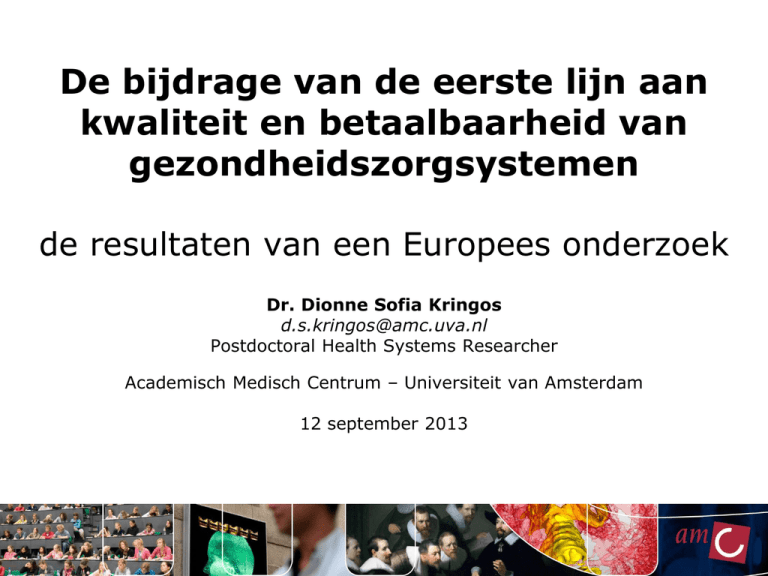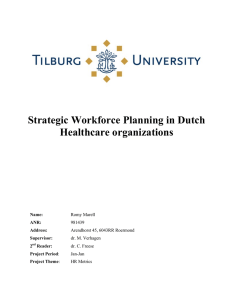more continuity of PC
advertisement

De bijdrage van de eerste lijn aan kwaliteit en betaalbaarheid van gezondheidszorgsystemen de resultaten van een Europees onderzoek Dr. Dionne Sofia Kringos d.s.kringos@amc.uva.nl Postdoctoral Health Systems Researcher Academisch Medisch Centrum – Universiteit van Amsterdam 12 september 2013 Inhoud 1. Hoe kunnen we de sterkte van de eerstelijns gezondheidszorg in Europese landen meten en vergelijken? 2. Hoe komt het dat landen hun eerstelijns gezondheidszorg systeem verschillend structuren en organiseren? 3. Wat draagt een sterke eerste lijn bij aan de volksgezondheid en andere belangrijke uitkomsten? PHAMEU project: measuring the strength of PC systems in Europe - NIVEL (consortium leader) - University of Tartu - IRDES - Heinrich Heine University - University Witten/Herdecke - CERGAS - University of Tromso - Jagiellonian University - University of Ljubljana - IDIAP Jordi Gol - ScHARR - University of Leicester - WHO Europe - European Forum for PC - EUPHA - EGPRN - European Commission Hoe kunnen we de sterkte van de eerstelijns gezondheidszorg in Europese landen meten en vergelijken ? PHAMEU MONITOR FRAMEWORK Dimensions of the PC structure Governance of PC system Economic conditions of PC system PC Workforce development Dimensions of the PC Process Access to PC services Comprehensiveness of PC services Continuity of PC Coordination of PC Dimensions of PC outcomes Quality of PC Efficiency of PC DIMENSIONS IDENTIFIED PRIMARY CARE STRUCTURE & PROCESS Dimensions of the PC structure Governance of PC system Economic conditions of PC system PC Workforce development System goals Equity in access policies Collaboration policies (de)Centralization Quality management Patient advocacy PC expenditures PC coverage Employment status Remuneration system Income of PC workers Profile PC workforce Professional status Supply and planning Academic status Prof. associations Total: 12 indicators Total: 11 indicators Total: 16 indicators Dimensions of the PC Process Access to PC services Comprehensiveness of PC services Continuity of PC Coordination of PC Density PC workforce Geographic availability Access at practice level Affordability of services Patient satisfaction First contact care Disease management Sole GP contacts Medical procedures Preventive care Health promotion Medical equipment Longitudinal continuity Informational continuity Relational continuity Gatekeeping system Skill mix Collaboration of care Public health integration Total: 12 indicators Total: 10 indicators Total: 9 indicators Total: 7 indicators MAPPING THE RELATIVE STRENGTH OF PC PC Governance Vision Equality access Decentralization Quality mngt infr. Patient advocacy Multidisc. collab. 0 Turkey Lithuania Malta Slovak Rep. Bulgaria Estonia Greece 40000 Czech Republic 60000 Romania France Annual Gross Income GPs 140000 120000 100000 80000 TR €27,000 20000 Austria Finland Turkey Sweden Portugal Malta Luxembourg Iceland Germany 25.6 % CH Denmark 5 160000 Top 5 HIGH LOW LU €150,000 DK €135,000 UK €133,000 CH €126,006 FR €125,659 LT €10,782 MT €10,808 SK €12,000 BG €13,688 EE €17,500 Czech Republic Italy Norway Bulgaria Estonia Slovak Rep. Latvia Cyprus Romania Hungary Slovenia Ireland Poland Lithuania Spain Netherlands Belgium 10 Hungary Poland Slovenia Spain Latvia Italy Sweden Cyprus Portugal Greece United Kingdom 15 Finland Iceland Belgium Germany Austria Ireland 0 Netherlands Switzerland 30 Norway France Switzerland United Kingdom Denmark Luxembourg Economic conditions 25 PC Exp.%THE 20 14.7 % NL 10.3 % HU 4.7 % CZ No data Workforce Development 3 types PC Physician Profiles GPs (FI, NL, NO, PT, RO, UK) GPs, OBGYN, PAED (BG, MT, SI, ES) GPs & Specialists (AT, BE, CY, CZ, DK, EE, FR, DE, GR, HU, IS, IT, LV, LT, LU, PL, SK, SE, CH, TR) GPs average 55+ yrs in 12 countries 21% med. graduates postgrad. FM PC Nursing training in 8 countries Level of PC Orientation at STRUCTURE of 31 Health Care Systems PC Workforce development HIGH MEDIUM LOW HIGH CY IS LU PL SK IT ES NL RO SI UK MEDIUM HU DK LT PT BG CZ GR AT FR LV SE TR BE DE FI CY IE IS LU CH HU SK MT PL LOW LOW CH IE MT BE DE FR AT BG CZ SE TR GR LV EE NO MEDIUM HIGH BG CY CZ AT LV SK GR IS LU PL MEDIUM FI EE IT LT NO RO EE NO FR HU LT SE TR DE BE IT RO HIGH DK ES NL PT SI UK LOW PC Governance IE MT CH DK PT ES FI NL SI UK PC Workforce Development PC Economic conditions Opportunities optimise Access to PC services Majority PC prov. specialists Interregional GP density difference >36 GPs per 100,000 pop. GP shortages <2 or 10> GP home visits/wk Never/Occ. telephone consult. Never/Occ. appointm.systems >16% patient GP not affordable % single handed PC practices 15-20% <5% 90-95% 75-80% 90-95% <10% <5% 36% 25-35% 20-25% 40-45% 60-65% 75-80% 70% 45-50% <10% 95-100% 100% 95-100% 95% 63% 15-20% 75-80% <5% <5% 65-70% 65-70% 95-100% 40% <5% 15-20% Level of PC Orientation at PROCESS of 31 Health Care Systems AT DE IS NO RO SK GR MT BE CH FR LU LV BG CY IE TR HIGH MEDIUM LOW HIGH EE FI IT HU PL PT UK CZ DK ES MEDIUM SE LT NL SI AT IT SE FI NO RO DE EE IS SK GR LU MT TR BG CH CY FR BE IE LV LOW MEDIUM HIGH AT TR BG CY HU NO RO DE IE IS SK IT LU CH FI FR PT BE CZ EE LV HIGH HU MEDIUM CZ PT LOW Coordination of care DK ES LT NL PL SI UK LOW PC Access GR LT MT NL SE SI PL UK ES DK Coordination of care Continuity of care CONCLUSION I PC systems in Europe strongly vary in strength Common themes to improve PC (e.g. vision, inequity in access, payment systems, workforce shortages, cooperation and coordination) PC system management requires improved PC information systems at the national level Hoe komt het dat landen hun eerstelijns gezondheidszorg systeem verschillend structuren en organiseren? ? Wealth – Result NHS & Social Health Insurance Systems: Wealthier countries in 1993 have weaker PC Strength and less Accessible PC Health care systems in Transitions: Wealthier countries in 1993 have more accessible PC, and more continuity of PC Governmental Composition – Result Countries that have predominantly been governed by (social-) democratic parties have a stronger PC structure, better PC access, and better coordination of PC Type of health care system – Result Social Health Insurance Systems: Countries with a SHI have a weaker access to PC, and a weaker continuity of PC Health care systems in Transitions: Countries with a health care system in transition have better access to PC, and more continuity of PC Values / Culture – Results Countries with a higher ‘desired governmental involvement’ have better access to PC, more continuity of PC, but less coordination of care, and less comprehensive PC Countries with a more family oriented culture have a weaker PC structure; less coordination of care; and less comprehensive PC Transitional countries with a more family oriented culture have better access to PC and more continuity of PC Countries where people rely more on science & technology to improve their health have less access to PC and more comprehensive PC CONCLUSION II PC systems in Europe strongly vary in strength due to differences in wealth, political composition of government, prevailing values, type of health care system Strengthening PC is in the end a political decision which can only be taken if it is in line with prevailing values in a country Wat draagt een sterke eerste lijn bij aan de volksgezondheid en andere belangrijke uitkomsten? ? Health care spending – Result Total health care expenditures were higher in countries with stronger PC structure But… Countries with more comprehensive PC services delivery had a slower growth in health care expenditures per capita Potential avoidable hospitalizations – Results • Having a stronger structure of PC is associated with a reduction in potentially avoidable hospitalizations for patients with asthma • Having a stronger access of PC is associated with a reduction in potentially avoidable hospitalizations for patients with COPD ; Reductions are even higher among the male population with diabetes • • Having a stronger coordination of PC is associated with a reduction in potentially avoidable hospitalizations for male patients with COPD Population Health – Results • Having a stronger PC structure is associated with a reduction in the potential deaths due to ischaemic heart disease; also for male patients with stroke; and for female patients with bronchitis, asthma or emphysema • Having a stronger coordination of PC is associated with a reduction in the potential years of life lost for patients with bronchitis, asthma or emphysema • Having a stronger comprehensiveness of PC is associated with a reduction in the potential deaths due to ischemic heart disease and due to stroke Socio-economic inequality in health – Results • Having a stronger continuity of PC is associated with less socio-economic inequality in poor self-rated health CONCLUSION III Strong PC is associated with better population health; lower rates of unnecessary (expensive) hospitalizations; relatively lower socioeconomic inequality More research need to measure contribution of PC to health system outcomes & variation within countries Further reading…. PhD Thesis: - Kringos DS. The strength of primary care in Europe. Utrecht University/NIVEL, 2012. ISBN: 978-94-6122-154-4. Analysis: - Kringos DS, Boerma WGW, Van der Zee J, Groenewegen PP. Europe’s Strong Primary Care Systems Are Linked To Better Population Health, But Also To Higher Health Spending. Health Affairs April 2013 vol. 32 no. 4, pp. 686-694. -Pelone F, Kringos DS, Valerio L, Romaniello A, Lazzari A, Ricciardi W, de Belvis AG. The measurement of relative efficiency of general practice and the implications for policy makers. Health Policy 107 (2012): 258-268. Measurement instrument: - Kringos D.S., W.G.W. Boerma, Y. Bourgueil, T. Cartier, T. Hasvold, A. Hutchinson, M. Lember, M. Oleszczyk, D. Rotar Pavlic, I. Svab, P. Tedeschi, A. Wilson, A. Windak, T. Dedeu and S. Wilm. The European Primary Care Monitor: structure, process and outcome indicators. BMC Family Practice 2010,11:81-98. - Kringos DS, Boerma WGW, Hutchinson A, Van der Zee J, Groenewegen PP. The breadth of primary care: a systematic literature review of its core dimensions. BMC HSR 2010, 10 (1):65-78.
